
Last modified: 2015-07-07 by pete loeser
Keywords: ufe | unidentified flags |
Links: FOTW homepage |
search |
disclaimer and copyright |
write us |
mirrors
Please note our Policy for Submissions and Enquiries.
Below is a series of images of flags that have been provided to FOTW; some we have recognized, and some we have been unable to recognize. If you can help us identify any of these flags, please let us know! Contact the: UFE Editor.Identification Key:
02-1. Three Axes Flag at World Cup
![]() Some Speculation
Some Speculation
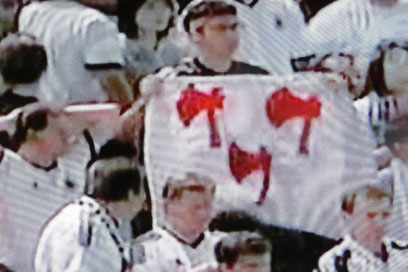
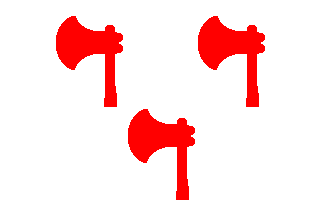
Photo from James Dignan, 30 January 2015, and image from Peter Hans van den Muijzenberg
During the World Cup final (2002: Brazil vs.Germany), around the 50th minute was seen on TV a white flag with three red axes. It looked more German than Brazilian. Can anyone identify it?
Ivan Sache, 1 July 2002
[Note from Editor: Back in 2002 this enquiry drew little comment until ten years later in 2012, when a short series of speculations (8) about the style and origins of the battle axes themselves emerged, but led nowhere. With James´ new discovery of an actual picture of the mysterious flag, hopefully this will finally lead us down the correct path of discovery...]
It may be of no help in identifying the flag, but I've uploaded a screenshot of this flag, described as a white flag with three red axes seen during coverage of the 2002 FIFA World Cup final. The flag is definitely being displayed among German fans (and it certainly looks more German than Brazilian).
James Dignan, 30 January 2015
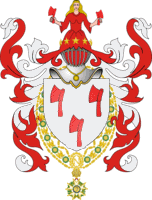 Image of Von Stetten Coat-of-Arms from Pete Loeser, 30 January 2015
Image of Von Stetten Coat-of-Arms from Pete Loeser, 30 January 2015
Well, that's easy, sort of: It's the banner of the arms of Von Stetten. Unfortunately, that begs the questions why that family is represented there, or what other entity it represents in this case.
Peter Hans van den Muijzenberg, 30 January 2015
There are several towns and villages in Germany called Stetten - maybe one of them uses the family´s arms?
James Dignan, 30 January 2015
Indeed we have evidence at "Stetten: Adelsgeschlecht" (German Wikipedia). Also the little village of Kocherstetten has similar arms, obviously modifying the family arms making the hilts blue, but with no flag shown. The flag displayed in 2002 was surely not a municipal flag, but the arms of the barons of Stetten indeed seem to be a good match.
Klaus-Michael Schneider, 31 January 2015
Perhaps one of the German team members was originally from a smaller German soccer (err...football) club, before he joined the national team, and is from an area whose fans use that flag to support their local club. Perhaps a fan brought his local banner to the "big game" to show support for and encourage his hometown player?
Pete Loeser, 31 January 2015
Kocherstetten is located beneath Stetten Castle, it belongs to Künzelsau City (Hohenlohe County) since 1 January 2012. It probably no longer has a proper flag. If it had, it wouldn't be our UFE, but a bicolour with centred or off-centred CoA. Sorry folks!
Klaus-Michael Schneider, 31 January 2015
Does Kocherstetten have a Soccer club, and do they have team banners? (Or the county, etc.?) I can't help but wonder if it isn't like our American Football team banners that fans use to indicate their support. I live in "Niner" county (San Francisco 49ers) about 10 miles from Levi Stadium where they play their home games in Santa Clara. It's about 50 miles south of San Francisco, and in every store there are different niner banners and fan flags for sale, I'd imagine it is the same for teams in Germany. Are we looking at one of the fan flags, perhaps no longer sold? Does anybody know the national team roster for the German national team in question, and more important, where were the players from?
Pete Loeser, 31 January 2015
Wikipedia is your friend! ![]() [but unfortunately, no direct connection to player´s backgrounds and flag seems to be there...]
[but unfortunately, no direct connection to player´s backgrounds and flag seems to be there...]
James Dignan, 1 February 2015
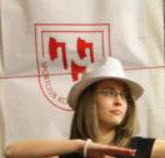 #1c
#1c
 #1d
#1d
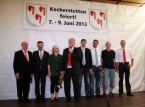 #1e
#1e
Images discovered by Klaus-Michael Schneider and Peter Hans van den Muijzenberg
This is speculation on my part, but based on some tantalizing clues provided our friends Klaus-Michael and Peter Hans. In an article about SC Kocherstetten (apparently a German sports and dance club associated with a local school/college?), a picture shows a group of girls doing a Michael Jackson dance routine. Hanging in the background appears a flag (white sheet with shield) that has very similar axe design to our original World Cup flag. See the picture link sent by Klaus-Michael. Interesting that the wording on the emblem reads "SPORTCLUB KO" - sounds a bit English to me.
In an article about Künzelsau City (Hohenlohe County), the village (700+ years old apparently), and the SC Kocherstetten, it talks about celebrating the club´s 50th Anniversary. You can see a couple pictures at the link, found by Peter Hans, that also indicate a connection.
My point is that possibly this was a flag from the area, possibly a school flag or campus organization, brought to the World Cup by somebody to show support for the German team.
I am hopeful that one of our German lists members who lives close enough to the school can contact them and direct their attention to our UFE photos and see if indeed there is a connection.
Pete Loeser, 2 February 2015

This flag has been identified as that of the English Premier Football League and is now on its proper page.
Lately I've noticed a black - medium blue - black, arranged horizontally auto tag on many vehicles in the area around Pittsburgh, Pennsylvania. Anyone know what this means?
John Evosevic, 3 July 2002
The Black-Blue-Black design is usually seen on a policeman's personal car or family members car. It stands for the "thin blue line". There is also a similar one with a red strip for firemen.
Jim Popovitch, 17 August 2002
The black-medium blue-black flag is actually a police mourning band. It is typically worn as a band across the badge when an officer is killed in the line of duty. I have seen it in use more frequently now as a bumper sticker, I believe this is probably a show of respect for the police officers killed on September 11th.
Troy Corwin, 26 September 2002
This design is an identification to notify other law enforcementpeople that the bearer also works in law enforcement. It representsthe "thin blue line, or brother police officer. The identification of fallen officers uses a badge with black tape or a black elastic band around the center. It is usually only worn when an officer dies, and is worn for up to a week after death, not everyday use.
Bob Cunningham II, 8 May 2006
Although this flag already has a positive identification. it is interesting that the British shipping company James Hall, located in Sunderland, had the same black over blue over black horizontal triband. Source: Lloyds flags and funnels, ed. 1912, p.81, image no.925.
Klaus-Michael Schneider, 9 February 2009
This flag is described as the flag of Singapore in the Polish Yearbook Swiat w Przekroju from 1960/61. I haven't seen it before.
O. Myszor, 20 May 2002
02-5. German Tank Flag
![]() Positive ID
Positive ID
![[German tank flag]](../images/d/de_ufe.jpg) Image sent by Mary Oldring
Image sent by Mary Oldring
Maybe you can help me. I don't know what this is called. This flag was removed from a German Tank in Holland during World War II. Any information you might have would be gratefully appreciated.
Mary Oldring, 11 Oct 2002
I believe that the yellow flag with a blue cross found on a German tank is Swedish. Soldiers from Sweden were fighting on both sides in World War II, so the crew on that tank probably was from Sweden. I have seen that flag as an alternative flag in Sweden before.
Ted Nordin, 24 Aug 2007
This is a pre-World War II German aircraft identification flag, based upon the Nationalist insignia of the Spanish Civil War. It was used by ground units to help friendly aircraft identify vehicles readily from the air. Designed to be stretched over a flat area of the vehicle that faced upwards. It was used in much the same manner as the "^" insignia was used by coalition forces in the Gulf War to prevent friendly units from being mistaken for the enemy.
Ken Bassford, 15 Oct 2009
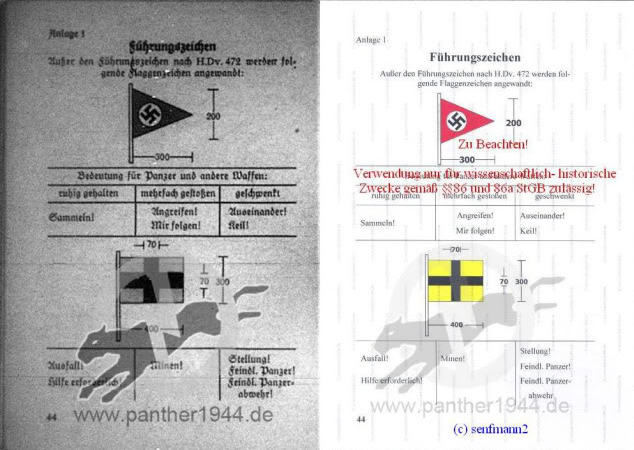 Image discovered by Alexander Manannikov, 16 August 2012
Image discovered by Alexander Manannikov, 16 August 2012
I think I can help you identify this flag, similar flags are shown at http://www.network54.com/Forum/637977/thread/1302265442/Ausfallflagge.
Alexander Manannikov, 16 August 2012
[Editorial Comment: A summary translation of the document Alexander discovered listed several similar flags, called Führungszeichen, that German Tiger companies used for communications. For example, one flag (white/red/black) with a cross was used to give commands on the move to change formations and actions to be taken (meet, attack, wedge, etc.). A yellow flag with a black cross appeared to be a danger flag (warning for mines, enemy antitank gun, tank out of action, or needing help). However, the text doesn't specifically mention a yellow flag with a blue cross.]

This flag was identified and now can be found on its proper page at German Vehicle Recognition Drapes (World War II).
02-7. Upside down "Y" Flag
![]() Positive ID
Positive ID
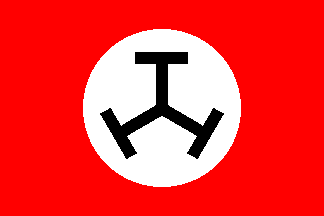
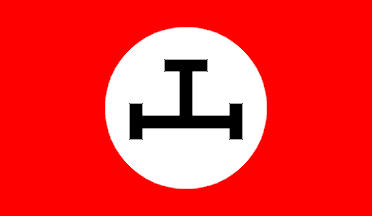
This has been identified as one of the Ku Klux Klan, LLC Flags and is now on the KKK page.
02-8. Walkyrie Flag
![]() Tentative ID
Tentative ID
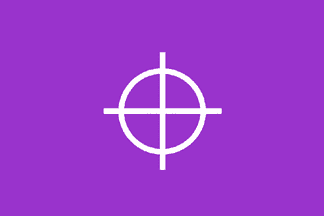 Image by Jaume Ollé, 05 Jun 2000
Image by Jaume Ollé, 05 Jun 2000
Nazi group Walkyrie (I don't know what country); source: communication from José Luís Cepero.
Jaume Ollé, 5 June 2000
This may be a current flag used by the Golden Dawn Movement in Greece. (Other groups use similar ones.)
Rick Prohaska, 30 January 2010
Good point: They do use a cross with a circle: Golden Dawn (Political organization, Greece). The snag is that the Golden Dawn Movement always uses a very Celtic-like Cross, so this may indeed be another group using it.
Peter Hans van den Muijzenberg, January 30, 2010
02-9. Unknown Nazi German Eagle Flag
![]() Positive ID
Positive ID
This flag has been identified as a Deutscher Schützenbund, or German Rifle Club flag of the Third Reich.
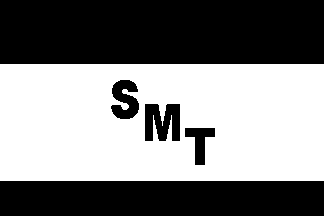 Image by Bill Sullivan, 27 Nov 2000
Image by Bill Sullivan, 27 Nov 2000
This unknown house flag(?) was submitted without country, location, or origin. Does anybody recognize it?
Bill Sullivan, 27 Nov 2000
Well, the only SMT with cascading lettering I managed to find were "Society for Sales & Marketing Training". Maybe if you asked them?
Peter Hans van den Muijzenberg, 12 February 2012
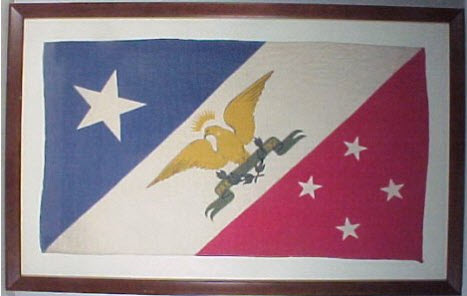
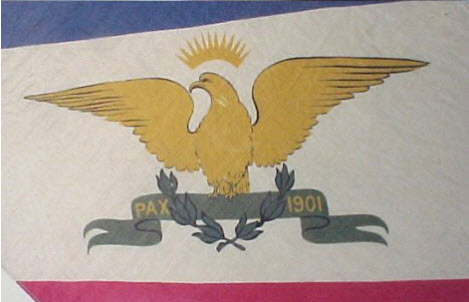 Detail of emblem
Detail of emblem
Images from Bill Garrison, 3 June 2002
We are really not sure of just what this flag represents, but we believe that it is a Spanish American War Era Regimental Flag. It measures approx. 21" x 12" and pictures an Eagle in the central panel perched on a Army green ribbon which reads "Pax 1901". The left hand panel depicts a single white star on a blue field and the right hand panel has 4 white stars on a red field. The flag was sold to us as a Pan-American Exposition Flag, but it sure looks a lot more like a regimental flag to us. If anyone can help with any information regarding this flag please email us and we will pass it along. The flag is of medium weight flag linen material and is in excellent condition with the only damage being a very small tear on the neck of the eagle - the colors are bright and the flag is VERY attractive. It looks as if it was recently mounted in a modern wood frame for display. Simply a beautiful c1900 flag and we believe it may possibly be a very important military regimental piece.
Bill Garrison, 3 June 2002
The reason UFE02-11 was identified as an exposition flag is because that is what it is, a Pan-American Exposition souvenir flag. This eagle is not even similar to the eagle used on US regimental flags.
James Ferrigan, 27 December 2014
Thereby taking the words out of my mouth. This doesn´t "*remotely" resemble any U.S. regimental flag, ever.
Joe McMillan, 27 December 2014
Erm, see anything familiar on this page of Doing the Pan.
Peter Hans van den Muijzenberg, 30 December 2014